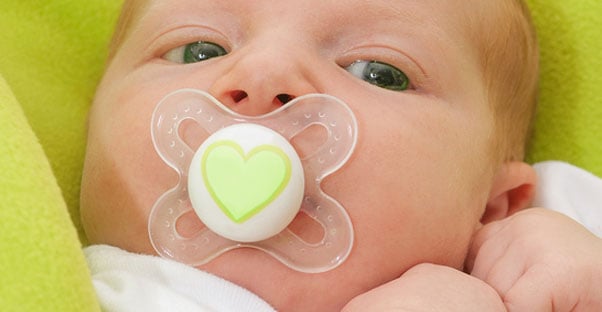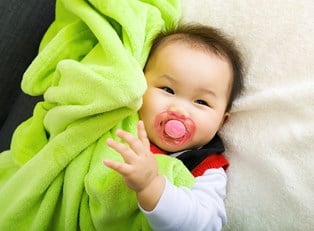For most babies, the sucking reflex begins around the 32nd week of pregnancy. Although this reflex is satisfied for some babies during mealtime, others need a little extra. Suckling is soothing for newborns, which is why pacifiers can be such a lifesaver for harried parents, but some infants just don’t care for them, and that’s okay too. Pacifiers have been a hot-button parenting issue for decades, swinging back and forth between wildly dangerous and totally wonderful. The American Academy of Pediatrics (currently) has nothing against them, but ultimately the choice is up to you and baby.
The Point of Pacifiers
Pacifiers can be a soothing distraction, particularly for fussy babies between meals. Pacifiers are affordable (you can find one for less than $1), disposable, and easy to sanitize. Additionally, some research shows a correlation between pacifier use and a decreased risk of SIDS. Sleeping with a bottle can potentially cause a choking hazard, while pacifiers create the same sensation without the liquid. Pacifiers are also great for a quick distraction when it’s time for vaccines.
Sleeping With a Pacifier
One of the biggest concerns of most experts is the sensation of sucking a pacifier creates without actually getting any milk. Babies who fall asleep with pacifiers may not wake for a midnight feeding, which means he isn’t getting as many calories as he needs. If you use a pacifier to put Baby to sleep, make sure to remove it once he’s conked out to ensure he knows when he gets hungry. Conversely, falling asleep with a pacifier can also mean Baby wakes up every time it falls out. Removal can help minimize this problem as well.
Pacifiers and Breastfeeding
Most lactation experts urge against using pacifiers with breastfed-only babies for the first six weeks. The difference in nipples can be confusing and could make latching and sucking more difficult, especially for newborns already facing problems. However, it’s also important to remember this is a personal choice, and if you need the pacifier, you can make that decision. For the most part though, experts recommend waiting until your newborn is used to feeding and his feeding schedule before introducing a pacifier to prevent confusion.
Pacifier Safety
No matter how much you love vintage, do not use vintage pacifiers. Choose new products made of the latest materials and technology, so you know it meets safety standards. Older pacifiers may be less safe or less effective, depending on what they’re made of and how they’re constructed. Some even pose choking hazards. Products made all in one piece limit choking hazards. Sanitize pacifiers by boiling them or using the sanitize function on a dishwasher. You can also replace them regularly.
Pacifiers with Older Babies
Many babies eventually get tired of using a pacifier, but some need help to kick the habit. Prolonged use may impact the way teeth grow in. There may be a connection with pacifier use and ear infections, although most babies don’t start getting ear infections until six months of age. As your baby gets close to the six-month mark, start limiting use a little at a time. If you’re having trouble, talk to your pediatrician about the best way to wean your baby from a pacifier.




